Like everything else here at DevesTechNet, click on the picture to get its highest resolution. Makes it easier to see!
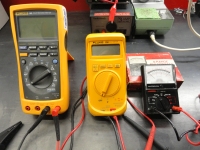 We should start by discussing the differences in Multimeter types. There are many but the ones that matter for our purposes are Analog vs Digital. We live in the Digital age and it's really a good thing because we can gain much more accuracy with Digital. Here are the three meters I have handy: From left to right, there is the Fluke 189 True RMS Multimeter, then the Venerable Fluke 12B, then there is El Cheapo. My good friend EL and I have been around for a long time and I have used this meter a great deal over the years. The problem with it is very apparent when using them side by side. The Analog Micronta Radio Shack $5.99 Special (EL) is very similar to what you get today with the Harbor Freight model. I am including some pictures I shot today so you can see why the Digital is preferred. Before I do, let me say that the middle one, the Fluke 12B is my favorite and the one I use the most. The 189 is way overkill for most things. I will explain where it's not as I get there. Here is the differences in readings just shoving the leads into the nearest AC outlet, being CAREFUL to set each meter to the proper AC Volts setting. This is important because forgetting to do that one time with EL will ruin the fragile meter movement.
We should start by discussing the differences in Multimeter types. There are many but the ones that matter for our purposes are Analog vs Digital. We live in the Digital age and it's really a good thing because we can gain much more accuracy with Digital. Here are the three meters I have handy: From left to right, there is the Fluke 189 True RMS Multimeter, then the Venerable Fluke 12B, then there is El Cheapo. My good friend EL and I have been around for a long time and I have used this meter a great deal over the years. The problem with it is very apparent when using them side by side. The Analog Micronta Radio Shack $5.99 Special (EL) is very similar to what you get today with the Harbor Freight model. I am including some pictures I shot today so you can see why the Digital is preferred. Before I do, let me say that the middle one, the Fluke 12B is my favorite and the one I use the most. The 189 is way overkill for most things. I will explain where it's not as I get there. Here is the differences in readings just shoving the leads into the nearest AC outlet, being CAREFUL to set each meter to the proper AC Volts setting. This is important because forgetting to do that one time with EL will ruin the fragile meter movement.
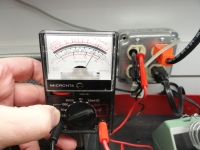
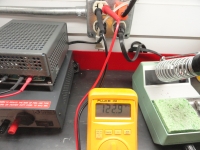
The Analog reading is using the bottom scale and you have to convert in your mind the fact that you are reading 15 volt scale on the face, but you are on the 150 volt setting. So it's reading about 125 volts. It's a guestimate and it's very reliable in it's ability to get you in the ballpark. This is also true with DC. Here are a few shots of the same only this time using a 13.8 VDC Power Supply that is made to emulate your Vehicles power system.
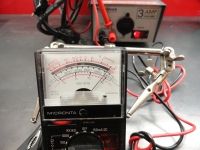

So as you can see, a more accurate reading is obtainable by going with a Digital readout. I prefer Fluke because I worked with them when I was with the government (and I am here to help). They are accurate and very durable. The 12B costs around $50 used. The new version is the 17B for around $100. That one even has the ability to read Amps like the old 189. I would gladly spend the $100 for the Fluke 17B because I know it's a quality tool and you will have it forever.
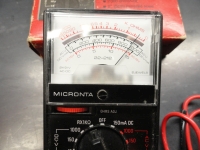

So far we have seen that we can read both AC and DC Voltage with both Analog and Digital Meters. How do they compare when reading Resistance? Let's find out. The pictures left and right are when reading a 300 ohm resistor. The Ohm Scale on any Multimeter is probably the one you will use most. EL is read using the top scale with the only Resistance Setting that is available is the 1K setting. So as you can see, its reading about 300 ohms. I am older now and can't be bothered with trying to read these scales and worry that I didn't see correctly, so I highly recommend getting a Digital. Also, the Ohms Scale is your Continuity feature. Zero Ohms is a Dead Short. More on that later.

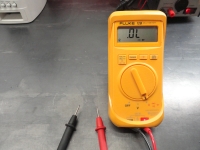
You can and should test your new wiring thoroughly with power OFF before applying power. This is done by checking each wire end to end. The trick to doing it by yourself when the other end of the wire you want to check is under the hood and you are under the dash is one of two things; test the wires in pairs, twist or jumper one wire to the other on one end, then put your leads on the two wires on the other end, or get yourself a nice long piece of 14 gauge wire and put alligator clips on each end, then clip the negative lead to one end, the furthest away end to the wire under test. This is what the wire Continuity Check looks like with the Digital Meter. With EL, it would be full scale deflection. You either read nothing or you read a dead short. Very nice differentiating ability. There is no middle ground. It is either connected or it isn't.
Next week we will discuss what happens when reading resistance (like the 300 ohm test above only you don't know where it's coming from). This is where Troubleshooting begins. Once you have your very own Digital Multimeter, it will not be long before you know exactly where most problems are and how to fix them. If there is time, I will also go into how to read Amperage on the more high end Multimeters (like the 17B) so you can see how much current draw your accessories are pulling.
 We should start by discussing the differences in Multimeter types. There are many but the ones that matter for our purposes are Analog vs Digital. We live in the Digital age and it's really a good thing because we can gain much more accuracy with Digital. Here are the three meters I have handy: From left to right, there is the Fluke 189 True RMS Multimeter, then the Venerable Fluke 12B, then there is El Cheapo. My good friend EL and I have been around for a long time and I have used this meter a great deal over the years. The problem with it is very apparent when using them side by side. The Analog Micronta Radio Shack $5.99 Special (EL) is very similar to what you get today with the Harbor Freight model. I am including some pictures I shot today so you can see why the Digital is preferred. Before I do, let me say that the middle one, the Fluke 12B is my favorite and the one I use the most. The 189 is way overkill for most things. I will explain where it's not as I get there. Here is the differences in readings just shoving the leads into the nearest AC outlet, being CAREFUL to set each meter to the proper AC Volts setting. This is important because forgetting to do that one time with EL will ruin the fragile meter movement.
We should start by discussing the differences in Multimeter types. There are many but the ones that matter for our purposes are Analog vs Digital. We live in the Digital age and it's really a good thing because we can gain much more accuracy with Digital. Here are the three meters I have handy: From left to right, there is the Fluke 189 True RMS Multimeter, then the Venerable Fluke 12B, then there is El Cheapo. My good friend EL and I have been around for a long time and I have used this meter a great deal over the years. The problem with it is very apparent when using them side by side. The Analog Micronta Radio Shack $5.99 Special (EL) is very similar to what you get today with the Harbor Freight model. I am including some pictures I shot today so you can see why the Digital is preferred. Before I do, let me say that the middle one, the Fluke 12B is my favorite and the one I use the most. The 189 is way overkill for most things. I will explain where it's not as I get there. Here is the differences in readings just shoving the leads into the nearest AC outlet, being CAREFUL to set each meter to the proper AC Volts setting. This is important because forgetting to do that one time with EL will ruin the fragile meter movement.

The Analog reading is using the bottom scale and you have to convert in your mind the fact that you are reading 15 volt scale on the face, but you are on the 150 volt setting. So it's reading about 125 volts. It's a guestimate and it's very reliable in it's ability to get you in the ballpark. This is also true with DC. Here are a few shots of the same only this time using a 13.8 VDC Power Supply that is made to emulate your Vehicles power system.


So as you can see, a more accurate reading is obtainable by going with a Digital readout. I prefer Fluke because I worked with them when I was with the government (and I am here to help). They are accurate and very durable. The 12B costs around $50 used. The new version is the 17B for around $100. That one even has the ability to read Amps like the old 189. I would gladly spend the $100 for the Fluke 17B because I know it's a quality tool and you will have it forever.


So far we have seen that we can read both AC and DC Voltage with both Analog and Digital Meters. How do they compare when reading Resistance? Let's find out. The pictures left and right are when reading a 300 ohm resistor. The Ohm Scale on any Multimeter is probably the one you will use most. EL is read using the top scale with the only Resistance Setting that is available is the 1K setting. So as you can see, its reading about 300 ohms. I am older now and can't be bothered with trying to read these scales and worry that I didn't see correctly, so I highly recommend getting a Digital. Also, the Ohms Scale is your Continuity feature. Zero Ohms is a Dead Short. More on that later.


You can and should test your new wiring thoroughly with power OFF before applying power. This is done by checking each wire end to end. The trick to doing it by yourself when the other end of the wire you want to check is under the hood and you are under the dash is one of two things; test the wires in pairs, twist or jumper one wire to the other on one end, then put your leads on the two wires on the other end, or get yourself a nice long piece of 14 gauge wire and put alligator clips on each end, then clip the negative lead to one end, the furthest away end to the wire under test. This is what the wire Continuity Check looks like with the Digital Meter. With EL, it would be full scale deflection. You either read nothing or you read a dead short. Very nice differentiating ability. There is no middle ground. It is either connected or it isn't.
Next week we will discuss what happens when reading resistance (like the 300 ohm test above only you don't know where it's coming from). This is where Troubleshooting begins. Once you have your very own Digital Multimeter, it will not be long before you know exactly where most problems are and how to fix them. If there is time, I will also go into how to read Amperage on the more high end Multimeters (like the 17B) so you can see how much current draw your accessories are pulling.



 Welcome to Deves Technet.com Forums. I encourage everyone to register so we can get a better idea of the traffic and its usefulness. Please leave a word or two describing your stay and what we can do to make it more enjoyable. Thanks!
Welcome to Deves Technet.com Forums. I encourage everyone to register so we can get a better idea of the traffic and its usefulness. Please leave a word or two describing your stay and what we can do to make it more enjoyable. Thanks!